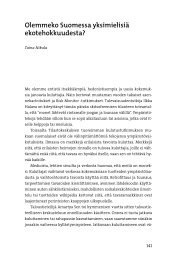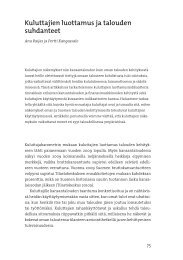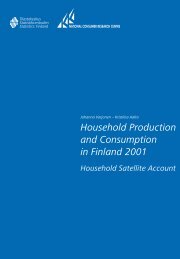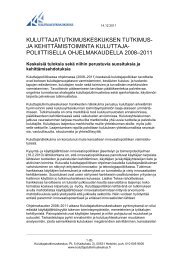Household Production and Consumption in Finland 2001
Household Production and Consumption in Finland 2001
Household Production and Consumption in Finland 2001
You also want an ePaper? Increase the reach of your titles
YUMPU automatically turns print PDFs into web optimized ePapers that Google loves.
7.2 Integration with the whole national<br />
economy<br />
International comparability is an important aim of the national accounts.<br />
Figures describ<strong>in</strong>g the extended economy open up a new dimension of<br />
comparability, br<strong>in</strong>g<strong>in</strong>g non-market production <strong>in</strong>to the equation <strong>and</strong> <strong>in</strong> this<br />
way provid<strong>in</strong>g a clearer picture of the true size of different national economies.<br />
Extended figures also help to form a clearer assessment of GDP growth from a<br />
welfare po<strong>in</strong>t of view, s<strong>in</strong>ce services produced <strong>in</strong> household production are<br />
specifically <strong>in</strong>tended for household consumption. International comparability<br />
requires household satellite accounts to be compiled on the basis of<br />
harmonised pr<strong>in</strong>ciples <strong>and</strong> methods. As yet no such recommendations are <strong>in</strong><br />
place <strong>in</strong> the European Union.<br />
Table 3 <strong>in</strong> Appendix 9 <strong>in</strong>tegrates non-SNA household production with the<br />
national economy accounts (goods <strong>and</strong> services account, production account<br />
<strong>and</strong> generation of <strong>in</strong>come account). The columns <strong>in</strong> this table represent the<br />
whole economy (column 1), the whole economy less SNA own-account<br />
production (6) <strong>and</strong> the extended economy (7). Table 4, then, shows the<br />
relative proportions with which the whole economy is extended when<br />
non-SNA household production is <strong>in</strong>corporated.<br />
The <strong>in</strong>clusion of household production <strong>in</strong> the national accounts causes<br />
various changes of various magnitude <strong>in</strong> different elements of production.<br />
GDP <strong>in</strong>creases by 40 per cent <strong>and</strong> real <strong>in</strong>dividual consumption by almost 60<br />
per cent. The biggest <strong>in</strong>crease at 79 per cent is recorded for employee<br />
compensation; this is because the value of labour <strong>in</strong> household production has<br />
been added to these figures rather than to the operat<strong>in</strong>g surplus (<strong>in</strong> follow<strong>in</strong>g<br />
the logic of the <strong>in</strong>put method). The relatively high proportion of labour <strong>in</strong><br />
household production as compared to market production is reflected <strong>in</strong> the<br />
fairly modest, 10 per cent <strong>in</strong>crease <strong>in</strong> <strong>in</strong>termediate consumption. Figures for<br />
gross fixed capital formation (+ 14 per cent) <strong>and</strong> for fixed capital consumption<br />
(+ 13 per cent) also underl<strong>in</strong>e the labour <strong>in</strong>tensiveness of household<br />
production.<br />
The impacts of <strong>in</strong>corporat<strong>in</strong>g household consumption <strong>in</strong> the structure of<br />
the whole economy could also be shown from the vantage po<strong>in</strong>t of the figures<br />
for the extended economy. In this case the share of household production<br />
would be one-third <strong>and</strong> that of non-SNA production 28.7 per cent (see<br />
Chapter 5.1).<br />
The <strong>in</strong>clusion of household production <strong>in</strong> the national accounts drives up<br />
the share of service production. This growth derives from the <strong>in</strong>crease <strong>in</strong><br />
services related to hous<strong>in</strong>g, meals, cloth<strong>in</strong>g care <strong>and</strong> the care of children <strong>and</strong><br />
adults. It would be particularly <strong>in</strong>terest<strong>in</strong>g to know how large a proportion of<br />
these services are produced by bus<strong>in</strong>ess companies, the public sector <strong>and</strong><br />
households <strong>and</strong> what k<strong>in</strong>ds of shifts occur between these different sectors.<br />
Answers can be obta<strong>in</strong>ed by cont<strong>in</strong>u<strong>in</strong>g to <strong>in</strong>tegrate household production <strong>in</strong>to<br />
the supply <strong>and</strong> use framework of the national accounts <strong>and</strong> by produc<strong>in</strong>g<br />
relevant time series.<br />
National Consumer Research Centre Statistics F<strong>in</strong>l<strong>and</strong> 67
















